Antico: The Golden Age of Renaissance Bronzes
May 1, 2012, through July 29, 2012
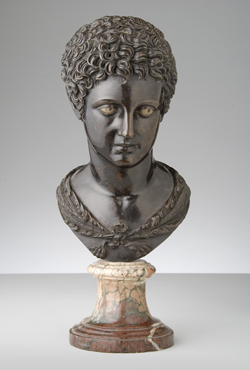 |
|
Young Hercules
c. 1500?
Bronze with silvered eyes
18th Earl of Pembroke, Wilton House, Salisbury, Wiltshire
|
Recently discovered and attributed to Antico, this bust's unique small scale suggests that Antico was inspired by similarly sized, classical fragmentary marble heads. He probably derived the miniature lion's pelt draped around the neck from images of Hercules on ancient coins. Antico balances the clarity of the hero's features with the barely contained energy of his tightly dressed curls. The silver gaze is directed inward, granting Hercules a visionary expression foreign to classical depictions of the hero.
 |
|
Youth (Alexander the Great?)
c. 1510
Bronze with oil gilding and silvered eyes
Sammlungen des Fürsten von und zu Liechtenstein, Vaduz-Vienna
|
The Youth's powerful long neck, tilted head, and age evoke renowned classical portraits of Alexander the Great. He wears a ribbon diadem found on ancient coins depicting Hellenistic rulers. His exotic, fringed cloak is appropriate to the vanquisher of the east who famously dressed in Persian garb. The tragic fate of the world's greatest conqueror, dying young before he realized his dreams of dominion, is echoed by the Youth's pathos. Antico's equally sensitive and inventive bust of Young Hercules (below) is similar to the Youth in expressive mood.
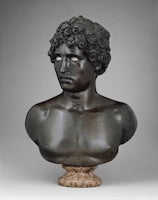 |
|
Young Man
c. 1520
Bronze with silvered eyes
The J. Paul Getty Museum, Los Angeles
|
Antico accurately reproduces the nearby classical portrait's scale, format, and features. He even records its complex pattern of curls. Yet the marble seems a pale echo of this startling bronze. Antico transforms the hair into dynamic coils of energy. He vividly sharpens the young man's features and endows him with an intense silver gaze. This remarkable portrait — more faithful to its ancient model than most of the master's work — underscores the creativity that made Antico the premier bronze sculptor to the Gonzaga courts.
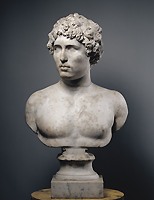 |
|
Roman
Young Man
c. AD 140–50
Marble
The Hispanic Society of America, New York
|
Throughout his life Antico worked as a restorer of ancient marble statues, returning them to a complete and perfect state. His profound knowledge of classical sculpture freed him to amplify the splendor of antiquity in his own art. This portrait, which was probably thought to be of a Roman emperor, served as Antico's model for the marvelous bronze in this gallery. The unprecedented comparison between these two sculptures reveals how indebted Antico could be to his classical sources, and how imaginatively he interpreted them.
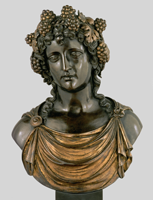 |
|
Bacchus
c. 1520–22
Bronze with oil gilding
Kunsthistorisches Museum, Vienna,
Kunstkammer
|
The Greek god of wine wears a burgeoning crown
of grapes, his gift to humankind and a source
of ecstatic inspiration. Antico depicts Bacchus
as sovereign over creativity. The god's sensual
features express a distant, poetic reverie. His dark
eyes amplify the depth of his introspective gaze.
Harmonious arcs of golden drapery echo his calm.
Probably composed late in life for Isabella d'Este,
Bacchus would have been displayed at a high level
to preside over her inspiring collection. In antiquity
deities were represented in full-length and never
as busts. Antico freely adapted this work from a
standing ancient Roman marble statue of Bacchus.
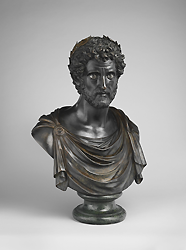 |
|
Emperor Antoninus Pius
Probably 1524
Bronze with oil gilding and silvered eyes The Metropolitan Museum of Art, Gift of Edward Fowles, 1965
|
Antico made this portrait late in life, when he was at the height of his artistic powers. It is based on Roman marble imperial busts, but the penetrating gaze and the mobility of expression far transcend classical examples. Antico uses color to emphasize meaning. The gilded laurel crown is an emblem of martial victory; the dark irises of the brilliant, troubled eyes reflect war's toll. The golden drapery slips down from the turning shoulders, implying perpetual readiness. At the Gonzaga court this remarkable work depicted the burden of rulership with a frightening honesty unthinkable in a contemporary portrait.
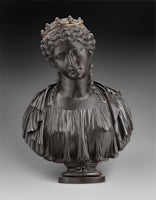 |
|
Cleopatra
c. 1525
Bronze with traces of oil gilding
Original bronze base
Museum of Fine Arts, Boston, William Francis Warden Fund
|
Antico's late bust of Cleopatra is an imaginary portrait without classical precedent. During the Renaissance the Egyptian queen's suicide was extolled as a heroic act. Cleopatra confronts the terrible choice between death or disgrace with regal dignity. She is magnificently robed and crowned, and gold earrings probably once dangled from her pierced ears. Her beautiful features are calm, her eyes thoughtful. On the bronze base, Antico depicts an asp, the poisonous instrument of death: the subject of her contemplation. He suggests that heroism stems not from physical strength but from character. Made for Isabella d'Este, Cleopatra symbolized the resolute spirit that is an inner source of female rulership. |


